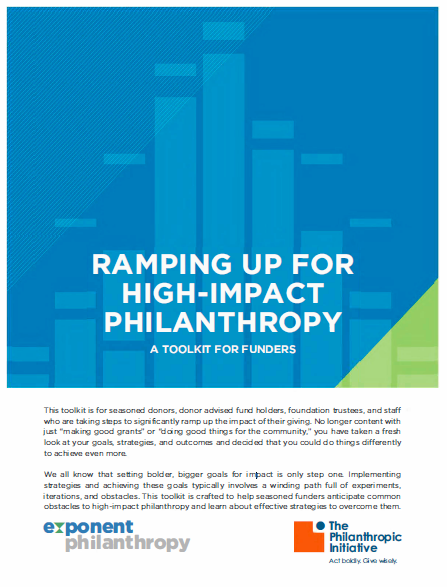This post is part of the Ramping Up for Impact blog series, which digs deeper into topics explored in the primer by The Philanthropic Initiative (TPI) and Exponent Philanthropy, Ramping Up Your Foundation: Key Considerations for Planning and Managing a Significant Increase in Giving. Click here to download the guide through Exponent Philanthropy’s website.
—
TPI has learned a great deal from nearly three decades of work with many different types of funders, including many who have gone through some type of ramping up process. Preparing for a ramp up is uniquely challenging and fulfilling. If I were only able to give a bit of advice to funders who are planning for a ramp up, it would be this:
Think big. Take the long view. And in doing so, enlist the help of others who bring diverse ideas and experiences to the table. In the words of philosopher Jeremy Bentham, “Dream no little dreams, for they have no magic to move men’s souls.”
The most exciting and rewarding philanthropic strategies are those that look to the future in visionary yet practical ways. This is true for individuals and families, foundations, and even corporations. Those who are ramping up through a growth in assets have the opportunity to set aspirational goals that may go far beyond previous thinking – and to craft effective roadmaps with the greatest potential for long-term impact.
For foundations that are poised to think big, strategically planning for a ramp up involves a process of dialogue and discovery – both internal and external – that enables stakeholders to determine what they hope to accomplish through this growth in assets and what path seems most promising to get there. The process requires choices along the way, and decisions on how best to allocate and integrate resources. While grants are often an important part of the equation, there are many other tools in the toolbox. Indeed, some of the most effective funders rely on an integrated strategy that incorporates grants, convenings, coalition-building, efforts to engage the public and influence public policy, and other creative ways to leverage greater impact.
The Nellie Mae Education Foundation offers a powerful example of thinking big and capitalizing on a ramping up process in order to achieve greater impact. Laser-focused on an ambitious goal – to promote student-centered learning at the secondary school level throughout New England – the Foundation’s philanthropic strategy is rooted in efforts to change practice at the school and district level; influence public policy at the local, state, and regional level; strengthen research and knowledge; and build public understanding and demand for student-centered learning. TPI’s recent strategy work with Nellie Mae involved intensive engagement of internal stakeholders, and enlisted external input in a variety of ways. As one part of the planning process, TPI facilitated an Idea Lab that brought Foundation leaders together with external thought leaders to construct a powerful theory of change. The Idea Lab helped lay the groundwork for a detailed strategic framework and plan to build public understanding of and demand for student-centered learning. Ultimately, the process integrated visionary and creative thinking with practical planning, enabling a significant ramp up in the Foundation’s work.
In our planning work, TPI is guided by some strongly held beliefs and principles that have been informed by our collective experiences over the years. Here are a few core principles that are exemplified in our work with Nellie Mae and are especially important for those going through a ramp up:
- The most effective philanthropic strategies emerge from an iterative, research-based, and creative process.
- Successful plans are flexible roadmaps, not something requiring lockstep thinking for years to come.
- The best planning is highly participatory and seeks to have widely-held ownership of its results.
- Strategic planning should provide the impetus for ongoing strategic learning. Plans with great potential allow room for strategies to emerge and evolve as funders learn and reflect.
- Critical review, analysis and dialogue, and course corrections are important parts of the life cycle of responsible and effective philanthropy.
Parts of this post are adapted from “Issues of Foundation Planning,” a chapter written by Leslie Pine and Joe Breiteneicher in From Grantmaker to Leader: Emerging Strategies for 21st Century Foundations.
—
TPI has worked with a number of families, foundations, and corporations at various points in the ramping up process, helping these clients successfully navigate the challenges that come with this transition. To learn more about our client work in this area, or if you are interested in engaging TPI’s consulting practice, please contact Ellen Remmer at eremmer@tpi.org or Leslie Pine at lpine@tpi.org.


